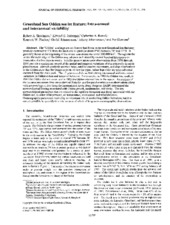| dc.description.abstract | The “Odden” is a large sea ice feature that forms in the east Greenland Sea that may protrude eastward to 5 °E from the main sea ice pack (at about 8 °W) between 73° and 77 °N. It generally forms at the beginning of the winter season and can cover 300,000 km2. Throughout the winter the outer edge of the Odden may advance and retreat by several hundred kilometers on timescales of a few days to weeks. Satellite passive microwave observations from 1978 through 1995 provide a continuous record of the spatial and temporal variations of this extremely dynamic phenomenon. Aircraft synthetic aperture radar, satellite passive microwave, and ship observations in the Odden show that the Odden consists of new ice types, rather than older ice types advected eastward from the main pack. The 17-year record shows both strong interannual and intra-annual variations in Odden extent and temporal behavior. For example, in 1983 the Odden was weak, in 1984 the Odden did not occur, and in 1985 the Odden returned late in the season. An analysis of the ice area and extent time series derived from the satellite passive microwave observations along with meteorological data from the International Arctic Buoy Program (IABP) determined the meteorological forcing associated with Odden growth, maintenance, and decay. The key meteorological parameters that are related to the rapid ice formation and decay associated with the Odden are, in order of importance, air temperature, wind speed, and wind direction. Oceanographic parameters must play an important role in controlling Odden formation, but it is not yet possible to quantify this role because of a lack of long-term oceanographic observations. | en_US |
